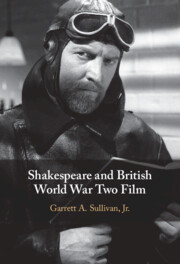Book contents
- Shakespeare and British World War Two Film
- Shakespeare and British World War Two Film
- Copyright page
- Dedication
- Contents
- Figures
- Acknowledgments
- Introduction
- Chapter 1 “Hamlet’s a Loser, Leslie”
- Chapter 2 “What We All Have in Common”
- Chapter 3 The Black-White Gentleman
- Chapter 4 “Bottom’s Not a Gangster!”
- Coda Two Cities Films and “the Spirit of Britain”
- Index
Introduction
Published online by Cambridge University Press: 24 March 2022
- Shakespeare and British World War Two Film
- Shakespeare and British World War Two Film
- Copyright page
- Dedication
- Contents
- Figures
- Acknowledgments
- Introduction
- Chapter 1 “Hamlet’s a Loser, Leslie”
- Chapter 2 “What We All Have in Common”
- Chapter 3 The Black-White Gentleman
- Chapter 4 “Bottom’s Not a Gangster!”
- Coda Two Cities Films and “the Spirit of Britain”
- Index
Summary
While most adaptation studies are organized around literary works, this book takes as its starting point British film production during World War Two. It situates four cinematic appropriations and one adaptation of Shakespeare—Leslie Howard’s Pimpernel Smith, Humphrey Jennings’s Fires Were Started, Leslie Arliss’s The Man in Grey, Powell and Pressburger’s A Matter of Life and Death, and Laurence Olivier’s Henry V—within wartime culture. The Introduction describes the book’s method, which is to develop a synchronic film history centered upon the “wartime Shakespeare topos” (or WST), a flexible cultural trope that links Shakespeare to national identity. While the WST was deployed to articulate what binds the British people together, it was also often used in period film to register social and cultural differences within the nation. In this regard, British cinema gives us a Shakespeare who simultaneously undergirds national identity and traces the fault lines within it.
Keywords
- Type
- Chapter
- Information
- Shakespeare and British World War Two Film , pp. 1 - 25Publisher: Cambridge University PressPrint publication year: 2022

